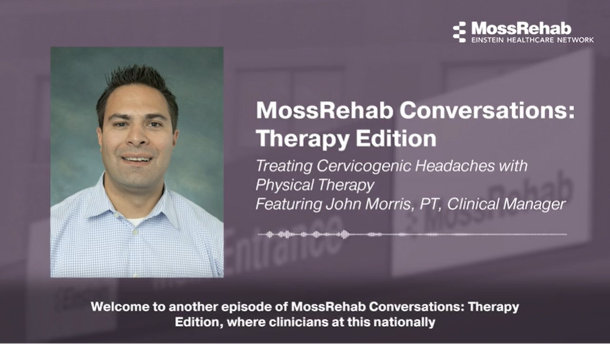
Most adults experience a headache at least once in their life. People often self-manage the symptoms with rest and pain medication. Some headaches, however, are treatable with physical therapy.
The most common types of headaches are migraines, tension, cluster, and cervicogenic. Each has different symptoms and treatments. Cervicogenic headaches usually happen on one side of the head and cause intermittent pain. These headaches are associated with neck pain or stiffness. So, a person who experiences muscle spasms or mobility restrictions along the cervical spine also could have a cervicogenic headache.
“People who experienced a trauma, whiplash injury, or spend a lot of sitting in poor postural positions are likely candidates for neck pain and associated cervicogenic headaches,” notes John Morris, PT, OCS, Clinical Manager of MossRehab Lansdale and Director of the Orthopedic Residency Program for Physical Therapists. “With more people working from home during the pandemic, workstations probably aren’t properly set up, causing spinal problems. I’ve seen an increase in headache referrals as more patients come in with neck pain.”
Studies indicate that almost 15 to 20% of those suffering from chronic or recurrent headaches may be cervicogenic in nature. And women are more four times more likely to have them than men. Physical therapy offers effective treatment in a short period to significantly reduce a patient’s symptoms, especially its frequency, duration, and intensity, and dependency on medication.
Treatment for Headaches
When treating a person with a cervicogenic headache, a physical therapist (PT) will perform a thorough exam that includes reviewing a patient’s medical history and patterns of pain as well as examining their posture, neck mobility, and strength of control in that region. Treatment focuses on restoring mobility in the spine using manual therapy including upper cervical rotation mobilization for acute and subacute headaches and thoracic mobilization for more chronic headaches. Exercise helps address strength and endurance deficits.
People are starting to realize that headaches are influenced by the spine and physical therapy can benefit them in managing their condition. “Those suffering from recurring headaches along with neck pain or stiffness should consider talking with their physician and asking about physical therapy,” remarks Morris.
Consult a Physician for Serious Headaches
Morris points out that individuals with severe headaches that come on very suddenly, cause nauseous, double vision or numbness should consult with a physician. These symptoms could indicate a serious condition. “Miriam Siegel, MD, Physiatrist at MossRehab Elkins Park and Program Director for the Brain Injury Medicine Fellowship at MossRehab, is one of our rehab physicians who specializes in headache disorders and is an excellent resource to receive consultation on more serious headaches.”
Listen to the Treating Headaches with Physical Therapy from MossRehab Conversations: Therapy Edition where Morris discusses how physical therapists can help people with headaches.